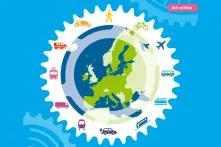
European transport infrastructure reflects the complexity of Europe’s cross-border management tasks and its historic path dependency. Railway infrastructure is a prominent example of this.

The European Union (EU) as a geographical entity is a relatively young historical phenomenon and idea of a Single European Railway Area is even younger. A European railway system is thus far from being realised. Railway infrastructure reflects the settlement structure of each individual country. France’s focus on the Île-de-France and a small number of other metropolitan areas and the long distances in between them is one of the reasons for the development of a high-speed network that is almost not used at all for ‘classical’ trains. While bigger cities such as Marseille, Bordeaux or Nantes are well-connected to Paris, there is little to no connection in between them. Furthermore, stations on high-speed lines are often located away from the cities that they aim to serve.
Until the 1980s and early 1990s, ‘through coaches’ (passenger cars that are re-marshalled during the course of their journey) were a common phenomenon in European trains. Nowadays, aerodynamically optimised high-speed trains and push-pull trains outside of the high-speed lines make this concept almost impossible.
Countries with a population that is more spread over the territory and with shorter distances in between more densely populated areas, such as Belgium or the Netherlands, tend to prioritise a schedule with a higher frequency of trains as opposed to a focus on a high-speed network. Countries such as the Czech Republic or other Central Eastern European states historically had a stronger focus on public transport and therefore also a denser rail network. Germany is a mix of both systems. A clock-face schedule, a timetable system under which public transport services run at consistent intervals, is still far from reality in most Member States.
Running railways is a highly complex undertaking, with the Forum Train Europe (FTE) (92 railway undertakings in 31 European countries) and the RailNetEurope (RNE) (36 railway infrastructure members in 25 different European countries) coordinating the timetables and the infrastructure in Europe. The strategic alignments of the different companies make this a challenging task: rail freight slots have to be coordinated with passenger trains. Night trains have to fit with the schedule of high-speed trains and local and regional railway undertakings have to be put in the position to both feed long-distance trains and provide a reliable service for daily commuters.
In varietate concordia (Unity in diversity), the official motto of the EU, is also an accurate description of the European railway landscape. When it comes to developing a European railway policy, it is important to bear in mind the different situations across the continent. Nevertheless, a comprehensive legal framework helps both service providers and customers by defining both tasks and services.
Despite all difficulties, investments in rail infrastructure and services have always had the advantage of long-term reliability if well maintained. While roads have to be renewed and repaired comparatively frequently, rail infrastructure and rolling stock are built to last for decades and therefore also have to be planned with a long-term vision.
The EU is addressing the challenges for a unified European Railway Area with its four railway legislative packages to date the creation of the European Union Agency for Railways (ERA) and the development of the European Rail Traffic Management System (ERTMS), among other things.
An important principle is the liberalisation of the European rail market. The general trend towards privatisation can also be seen in European railway undertakings. But states usually hold the majority of shares of the formally privatised companies.
Competition in European railway markets has led to many of the national companies becoming active in other Member States, competing with their national counterparts in their respective home countries. For example, in the form of its subsidiary Arriva, Deutsche Bahn AG has won the tenders to operate local trains in 13 EU Member States and the UK.
Open-access railway operators such as Regiojet (CZ/SK), Westbahn (AT) or Nuovo Trasporto Viaggiatori (IT) run their services as real competitors to the often parallelly operating state-owned railway undertakings at their own financial risk. Open-access operators mainly operate routes that are highly profitable or where they see a niche to operate in.
It is up to the legislators to define both minimum services and infrastructure in order to improve access in marginalised regions and create the best framework for this green mode of transport.
Sources for data and graphics: Vagonweb.cz, https://bit.ly/3pWkyuy; Welt, Konkurrenz auf der Schiene https://bit.ly/3fv3zdT; List of railway companies, Wikipedia, https://bit.ly/3nT0siO & https://bit.ly/3pZFQHx

